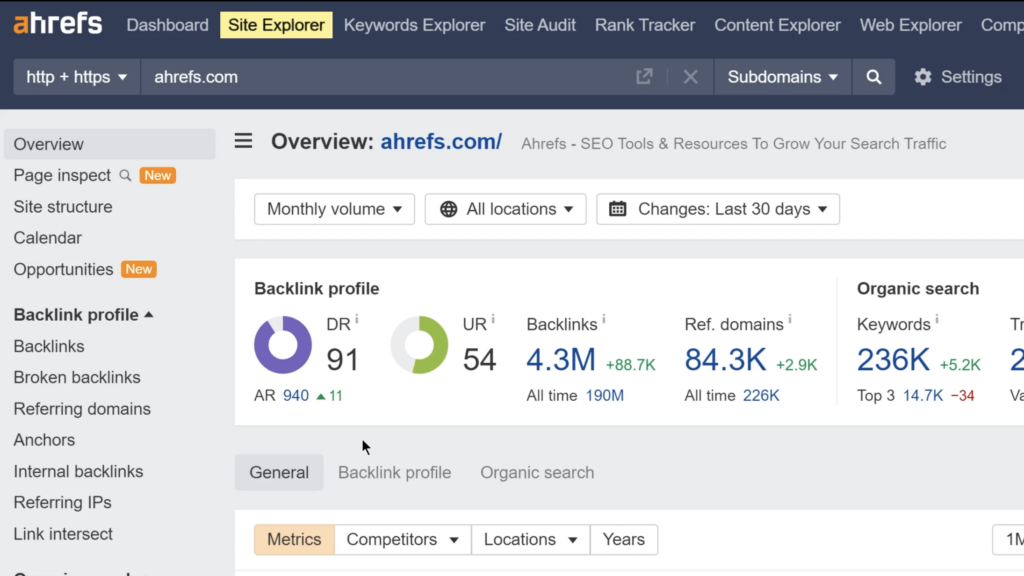Ranking in the top few spots of Google’s search results is the goal of any blog post you write. But without a proper understanding of SEO and the right SEO tips at your fingertips, claiming a top spot is like throwing spaghetti on the wall.
If you want to attract new daily readers to your blog by the thousands, it is crucial to optimize your search results in order to rank higher on Google Search Result. In this post, I’m going to share 7 powerful SEO tips to help you rank higher, securing a spot on Google’s coveted first page.

7 SEO Tips to Rank Higher on Google Search Result
Believe it or not, growing an audience for your blog is easier than growing an audience on social media. For starters, there isn’t a new medium to master every year or so (like how Instagram shocked old-school influencers with Reels). Then, there’s the added fact that the best SEO practices are consistent and rarely change dramatically.
Understanding the best SEO tips and practices goes a long way. While social media, email marketing, and digital ads are powerful marketing tools, organically holding a top spot on Google’s search results generates brand awareness and recognition for years. (Decades, even, especially if you follow the tips outlined in this post.)
Breaking Down the Importance of SEO
Google is the largest search engine in the world, clocking in approximately 8.5 billion searches worldwide daily. While Google does run on an algorithm that changes every now and then, it is pretty consistent with what it values and how it ranks a blog post higher on their search results.
It is undeniable Google is a key player in driving hoards of traffic to your website. But understandably, lots of new and more experienced bloggers get stuck in analysis paralysis whenever SEO enters the chat.
Here’s why…
Simplifying SEO Understanding
SEO, or search engine optimization, is often perceived as a difficult topic to understand for multiple reasons.
- The technical aspects of the term: Nothing makes a subject unapproachable, quite like ultra-specific industry jargon. SEO is no different, and the deeper you dig, the more you’ll encounter.
- It’s a broad topic that encompasses a lot: When initially researching SEO tips, you’re often met with a plethora of terms, ranging from on-page SEO, off-page SEO, keyword research, user experience… the list goes on and on and I get it–it’s overwhelming.
- The lack of immediate results: Unlike social media, you often have to wait a little longer before seeing results. SEO is a technical skill that requires analysis and patience, and it won’t grant you the same dopamine hits that receiving a few dozen likes on an Instagram post does.
Lucky for you, you don’t need to become an SEO expert to optimize your blog posts for searchability and discoverability. And with this blog post in your toolbelt, applying these 7 SEO tips will make it feel more approachable and manageable.
So, let’s dive right in with tip number 1.

Tip 1: Keyword Research and Optimization
Before you draft your blog post, you need to do a keyword research for your blog post.
Keyword research is a foundational step to any good SEO strategy because:
- It helps Google identify the terms and phrases that potential customers use to find answers, products, services, etc.
- Understanding your audience’s search queries allows you to write a blog post that directly meets your audience’s needs
- When done well, keyword research is what will rank you higher in search engine results pages (SERPs for short).
And the higher you rank, the more organic traffic you can expect to your blog.
How to Optimize Your Blog Posts with Keyword Research
In order to do this, you’ll want to use a keyword research tool. These tools will help you find which keywords are best to target. It’ll also provide valuable insight into what your target readers are searching for on Google.
Here are some tools to help you get started:
- Google Keyword Planner: This free tool provided by Google Ads helps you find keywords related to your business. It provides data on search volume, competition, and suggested bids for paid campaigns.
- Ahrefs: A comprehensive SEO toolset that offers advanced keyword research capabilities. It is widely used by SEO professionals for in-depth analysis.
- Keysearch: This SEO tool is designed to help users perform effective keyword research, track rankings, analyze competition, and improve their overall SEO strategy. (This is what the CreateHer Empire team uses!)

Tip 2: Create High-Quality Content
Keyword research and creating valuable, high-quality content go hand in hand. It wouldn’t matter if your blog posts rank for a keyword if the quality of the post isn’t valuable to your readers.
While there isn’t a secret to creating high-quality content, there are a few non-negotiables that need to be met for your blog post to be considered valuable.
3 Non-Negotiables to Writing High-Quality Blog Posts
1. Answer your audience’s questions in detail
Once you have your focus keyword, it’s important to write a blog post that answers every question your audience may have about the phrase.
It’s in good practice to do a quick Google search for the top 5 blog posts currently ranking for your targeted keyword. Read them through and ask if these posts are missing anything that could make it easier for your audience.
2. Write original content
I know it’s tempting to have ChatGPT write your entire blog post for you. Yes, it’ll save you time and allow you to churn out dozens of blog posts in a matter of minutes. However, Google is cracking down on A.I.-generated blog posts and ranking them as low-quality content.
Instead, ChatGPT is a great tool to streamline your research and drafting process. Ask it to generate an outline. You can also ask it to take on the point of view of your target reader and prompt it to generate a list of questions they would want answered in your blog post.
Get creative with how you use A.I., but do not copy and paste an entire blog post and call it a day.
3. Consider the length and depth of your blog post
Word count doesn’t dictate the quality of your post, but you’ll quickly realize that many of the top-ranking posts on Google fulfill a word count of 1000.
It’s generally considered good practice to write a blog post around 1500 words or more. I don’t suggest filling your post with fluff and keyword stuffing. Instead, strive to fulfill point #1 – answer your audience’s question in detail.
Focus on providing as much useful information as possible for your reader, and your word count will likely naturally increase.

Tip 3: Practice Good On-Page SEO Techniques
Search engines like Google use on-page SEO elements to scan a page’s matches to a user’s search intent. In other words, it uses elements like headings, alt-text, meta descriptions, content quality, and internal links to judge the relevancy of your blog post.
On-Page SEO Elements and How to Optimize Them
Meta Tags & Title Tags
Use your primary keyword near the beginning of the title tag to signal to search engines what kthe page is about. Be descriptive and compelling when creating a title, but make sure it accurately describes the content and encourages clicks.
Header Tags
Header tags (H2 and H3) create subheadings within the content, helping to organize and structure the information for your readers. H2 tags are used for major sections of content, and H3 tags for subsections within the H2 tags.
Optimize Images with Alt-Text
Image alt-text provides a textual description of the images on your blog post. You’ll want your alt-text to be descriptive yet concise. If possible, add your focus keyword to your alt-text but don’t stuff it unnecessarily.
Internal Linking
Internal linking just means linking to other pages within your website. This enhances user experience by allowing your readers to navigate to posts they might find interesting. As long as you’re linking to blog posts relevant to the topic they’re reading about.

Tip 4: Backlink Strategy
Backlinks are tremendously helpful when aiming to rank higher on Google Search Results. That’s because a link back to your blog from another site, especially one with high domain authority, signifies to Google that you are a relevant and trustworthy authority on a topic.
To simply put: sites with a higher number of quality backlinks typically rank better in search engine results pages (SERPs).
How to Get High-Quality Backlinks
Not to hit the nail on the head over and over again, but high-quality content is where it’s at again. Imagine writing a blog post that provides immense value to your readers, so much so that other bloggers are linking to it repeatedly.
While writing a high-quality blog post can certainly increase your chances of getting a backlink, it’s not a reliable or consistent approach.
What would be more reliable is to collaborate with other bloggers so that you’re building a mutually beneficial strategy. The Blogger Bootcamp Facebook group is a great resource when looking for collaborators.
Tip 5: Optimize for Mobile
A ton of Google searches are made on smartphones. This is why it’s incredibly important to optimize your blog posts for mobile users.
When purchasing a theme for your blog, you’ll want to make sure there’s an option for mobile users. Before you hit publish on a blog post, preview it on mobile.

Tip 6: Account for User Experience
A seamless and pleasant user experience encourages readers to stay on your blog post. Make sure that your page loads quickly, add more spaces between paragraphs, and ensure that your design is responsive.
Tip 7: Monitor Regularly and Optimize When Needed
Last but not least, you’ll want to make sure that your SEO efforts are working so that you can optimize your blog post when need be.
Use Google Analytics and Search Console to keep track of your blog post’s performance, and be sure to update your posts to reflect new information or any changes regarding the topic.
Final Thoughts on SEO and Ranking on Google Page 1
These 7 SEO tips will focus your attention to the most important elements of your SEO strategy. But remember, SEO is a long game, and it requires patience. The tips in this post are organized to keep you on track from the drafting of your blog post to after you hit publish.
But if you want to take it one step further and you’re ready to monetize your blog ASAP, get yourself in my free masterclass: 4 Steps to Running a Highly Profitable, High Traffic Blog.







+ show Comments
- Hide Comments
add a comment